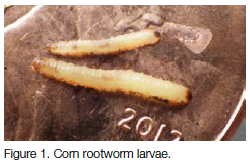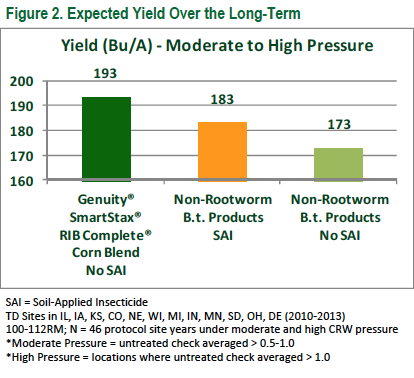Historical estimates suggest western corn rootworm (WCR) and northern corn rootworm (NCR) are responsible for nearly 1 billion dollars annually in crop losses and control costs.1 Larval feeding can decrease yield potential and increase the risk of root lodging. Although the average yield advantage is 20 bu/acre, data shows there can be an even greater impact of up to 80 bu/acre yield loss due to CRW.2 Predicting the extent of CRW damage is very difficult, but the potential for damaging populations is more probable under certain circumstances.

Practices That Can Increase CRW Pressure
In all areas of the Corn Belt, production practices that favor growth in CRW populations include: long-term corn rotations, late-planted fields, and/or planting of late-maturing products. For example, full season products used by many silage growers are often prime targets for escalating CRW beetle populations because they pollinate when other desirable adult CRW food sources have deteriorated.
Management Options
- Crop rotation has been and continues to be a recommended method to effectively control CRW larvae. However, rotation is no longer as effective in specific areas of the Corn Belt due to extended diapause populations of NCR and the soybean variant of WCR.
- Seeds with dual modes of action (MOA), such as Genuity® SmartStax® RIB Complete® corn blend, have proven to be a consistent CRW control tool.
- Soil-applied insecticides labeled for control of CRW larvae can be applied at planting with conventional seed products and along with single MOA B.t. seed products to add another MOA.
Research
In efforts to define the value provided by B.t. traits and SAI’s, Monsanto Technology Development Representatives conducted CRW control studies from 2010 to 2013 in twelve states to evaluate the rootworm protection efficacy of Genuity® SmartStax® RIB Complete® corn blend products compared to similar corn products without B.t. corn rootworm protection.
All products were adapted for the testing area and had their respective seed treatments. Nodal injury scores (NIS) and yield data were collected from the studies.
Results and Discussion
In Moderate to High Pressure Situations2 – Genuity® SmartStax® RIB Complete® corn blend products provided an advantage average of 20 bu/acre over non-rootworm B.t. protected corn products (Figure 2). When an SAI was used with non-rootworm B.t. protected products, there was a 10 bu/acre advantage for Genuity® SmartStax® RIB Complete® corn blend products (Figure 2). Genuity® SmartStax® RIB Complete® corn blend products had an NIS score of 0.29 compared to scores of 0.58 and 1.46 for non-rootworm B.t. protected products with and without an SAI respectively (Figure 3). An SAI would add about $16/acre to the cost of production and should be considered when selecting seed products.
In Low Pressure situations2 – Genuity® SmartStax® RIB Complete® corn blend products provided an 8 bu/acre advantage over non-rootworm B.t. products that did not have an SAI.4 If farmers determine they have a low risk for damage from a rootworm infestation, and decide to plant a nonrootworm B.t. product without an insecticide, 8 bu/acre in yield potential could be lost. The use of an SAI with non-rootworm B.t. products may provide adequate levels of rootworm control in instances of low pressure. However, due to difficulty of predicting damage levels, growers run an exceptional risk of under estimating damage potential; thereby, incurring substantial loss in yield. In the short-term, growers may realize a modest cost savings. However, the use of non-rootworm B.t. products alone or with an SAI will likely to cost growers more in the long-term.


Additional Considerations:
Regardless of high or low rootworm pressure, Genuity® SmartStax® RIB Complete® corn blend products can provide growers a better opportunity to maintain and increase profitability. Along with the $16/acre cost for an SAI, consideration should be given to:
- Soil-applied insecticides are relatively insoluble and protection is limited to a relatively small portion of the root zone.
- Genuity® SmartStax® RIB Complete® corn blend products offer earworm B.t. protection. Lost yield
attributable to earworm feeding can be as high as 7%.3
- Genuity® SmartStax® RIB Complete® corn blend products are treated with Acceleron® Corn Seed Treatment Products plus Poncho® 500/VOTiVO® seed treatment, which has shown an increased yield potential of 3.7 bu/acre over other basic seed treatments.4
- Farmers, through market research, have placed a value of $5/acre on refuge in the bag products.5
Genuity® Rootworm Management App
iPad® device users can download an app that allows farmers to complete assessments on each field to determine the potential risk of corn rootworm damage. The tool follows proven pest management recommendations for scouting, crop rotation, utilizing dual MOA when planting, and suggesting specific insecticides based on crop type. The app also allows growers to take notes, access scouting reports, set alerts, and share results by email. The app can be downloaded from or the iTunes® App Store.
Sources:
1 Croff, C.D. and P.D. Mitchell. 2007. When does it pay to plant RW Bt corn in Wisconsin? Proceedings of the 2007 Wisconsin Fertilizer, Aglime & Pest Management Conference, Vol.46.
2 TD Sites in IL, IA, KS, CO, NE, WI, MI, IN, MN, SD, OH, DE (2010-2013).
3 Boyd, M. and W. Bailey. 2001. Corn earworm in Missouri. MU Guide, University of Missouri-Columbia. https://mospace.umsystem.edu (verified 5/21/14).
4 2011 and 2012 Internal Monsanto Commercial Field Trials.
5 2011 Market probe farmer quantitative study.


